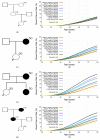Incorporating truncating variants in PALB2, CHEK2, and ATM into the BOADICEA breast cancer risk model
- PMID: 27464310
- PMCID: PMC5086091
- DOI: 10.1038/gim.2016.31
Incorporating truncating variants in PALB2, CHEK2, and ATM into the BOADICEA breast cancer risk model
Abstract
Purpose: The proliferation of gene panel testing precipitates the need for a breast cancer (BC) risk model that incorporates the effects of mutations in several genes and family history (FH). We extended the BOADICEA model to incorporate the effects of truncating variants in PALB2, CHEK2, and ATM.
Methods: The BC incidence was modeled via the explicit effects of truncating variants in BRCA1/2, PALB2, CHEK2, and ATM and other unobserved genetic effects using segregation analysis methods.
Results: The predicted average BC risk by age 80 for an ATM mutation carrier is 28%, 30% for CHEK2, 50% for PALB2, and 74% for BRCA1 and BRCA2. However, the BC risks are predicted to increase with FH burden. In families with mutations, predicted risks for mutation-negative members depend on both FH and the specific mutation. The reduction in BC risk after negative predictive testing is greatest when a BRCA1 mutation is identified in the family, but for women whose relatives carry a CHEK2 or ATM mutation, the risks decrease slightly.
Conclusions: The model may be a valuable tool for counseling women who have undergone gene panel testing for providing consistent risks and harmonizing their clinical management. A Web application can be used to obtain BC risks in clinical practice (http://ccge.medschl.cam.ac.uk/boadicea/).Genet Med 18 12, 1190-1198.
Figures



References
-
- Collaborative Group on Hormonal Factors in Breast C Familial breast cancer: collaborative reanalysis of individual data from 52 epidemiological studies including 58,209 women with breast cancer and 101,986 women without the disease. Lancet. 2001 Oct 27;358(9291):1389–1399. - PubMed
-
- Thompson D, Easton D. The genetic epidemiology of breast cancer genes. Journal of mammary gland biology and neoplasia. 2004 Jul;9(3):221–236. - PubMed
Publication types
MeSH terms
Substances
Grants and funding
LinkOut - more resources
Full Text Sources
Other Literature Sources
Medical
Research Materials
Miscellaneous

